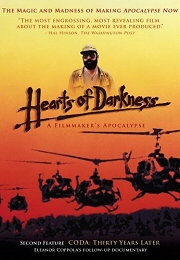- Rated R
- Documentary
- 1991
- DVD
Reviewed by Bob Westal
()
y movie is not about Vietnam...my movie is Vietnam. It’s what it was really like. There were too many of us, we had access to too much equipment, too much money, and little by little we went insane.” – Francis Ford Coppola
When the DVD special edition, “Apocalypse Now: The Complete Dossier,” came out back in 2006, nearly ever review (including Bullz-Eye’s) complained of one glaring omission rendering the "dossier" less than complete: the remarkable “making of” documentary, “Hearts of Darkness: A Filmmaker’s Apocalypse.” Reviewers were right to complain: the film is a must not only for fans of “Apocalypse Now,” but for everyone interested in filmmaking — an astonishing and instructive glimpse into the making of one the most trouble-plagued, yet ultimately brilliant, films in the history of American movies. Fortunately, owners of Blu-ray players can now obtain the film as part of the new "Full Disclosure" edition of the film. The rest of us can purchase it separately on DVD. Either way, it's easily one of the most remarkable behind-the-scenes stories in the history of cinema.
When production began on “Apocalypse Now,” Francis Ford Coppola was at an almost unheard of artistic apex, with three multi-award-winning, acknowledged instant classics under his belt. He had beat the odds in any number of ways – overcoming the doubts of studio honchos on “The Godfather” to make a gigantic, controversial international smash and Best Picture Academy Award winner. His follow-up was a “minor” low-key thriller, "The Conversation," that nevertheless won the Cannes Palm D’or and is a classic in its own right. He then astonished just about everyone with “The Godfather: Part II,” contradicting the conventional wisdom that sequels were always inferior to the originals, getting even better reviews and winning double the Oscars of the first film, including an unheard of second Best Picture win.
Even so, Coppola needed to mortgage himself to the hilt to help finance his wildly ambitious and far from conventionally commercial vision, “Apocalypse Now.” The project had begun in the mid-to-late 60s as a very loose adaptation of Joseph Conrad’s darkly moralistic English class perennial, “Heart of Darkness,” to be directed by the young George Lucas. As written by the hawkish John Milius (“Red Dawn,” “The Wind and the Lion”), it was to be a relatively straightforward, low-budget war film. Somewhat insanely, Milius and Lucas intended on actually shooting it in Vietnam at the height of the war. Not surprisingly, the project never happened.
Several years later, Coppola decided that "Apocalypse Now" provided just the canvas he was looking for to top his earlier triumphs. It was especially tempting for an acclaimed filmmaker with an expansive streak, because “Heart of Darkness” had eluded the young Orson Welles, who had originally intended to make that his first film, ultimately abandoning the project in favor of "Citizen Kane." Coppola’s middle name may have been “Ford,” but it was also “Hubris.”
Nor did he flinch from taking enormous risks in his Philippines-based shoot. Enlisting the aid of corrupt dictator Ferdinand Marcos, who would supply helicopters and uniformed extras, his location was within miles of a real life civil war pitting Marcos’ generals against communist rebels.
Once filming began, so did the problems. Coppola changed his mind about original star Harvey Keitel and replaced him with Martin Sheen, generating bad publicity for both Keitel and the production. Then, Coppola was plagued by logistical nightmares when helicopters and uniformed extras – actual government soldiers – were sometimes diverted to fight in the actual war.
But that was nothing compared with the sudden life-threatening heart attack of his then-troubled 36-year-old star, Martin Sheen, partway through shooting. Coppola dealt with the matter by using Sheen’s brother, Joe Estevez, for the narration and as a double for long shots and essentially praying that his star – who is featured in nearly every scene in the film – would soon be well enough to return and complete the role. That fortunately temporary absence of one star turned out to be nowhere near as large a problem as the eventual presence of another.
Marlon Brando, still a genuine superstar in the mid 70s, had been cast to play the crucial role of the enigmatic, genocidal Colonel Kurtz. The film Kurtz was to be pretty much identical to the Kurtz character in Conrad's novella – a deeply sincere altruist who turns to madness and extreme violence once outside the safe, if hypocritical, moral strictures of Western civilization. He was to look like a hero gone badly wrong, and Brando, who had been getting paunchier in his middle age, had promised to lose some weight before accepting the $3,000,000 role. However, the single most admired actor of his generation turned up not just with the small gut he sported in 1973’s “Last Tango in Paris,” but significantly overweight. With his head shaved bald he was, as pointed out in a “Saturday Night Live” sketch, practically a dead ringer for the Addams Family’s Uncle Fester.
Much worse, the increasingly lazy and uncooperative Brando refused to adjust the part to fit his increased girth and had failed to prepare in a number of ways; a highly literate and extremely intelligent man, the legendary Method actor failed to so much as read Conrad’s novella. Never had a director been so much at the mercy of single actor, and getting anything like the powerful ending Coppola needed with this apathetic star was going to prove impossible. Somehow, the film turned out to be mesmerizing anyway, though even the film’s most ardent supporters admit the ending is not what it could be. At least some of the responsibility falls on the hugely influential actor's shoulders and his oddly enervated performance.
Fortunately for the future of cinema, the director’s wife, Eleanor Coppola, had been persuaded to shoot documentary footage for a future “making of” documentary and had even been making sound recordings unbeknownst to her husband. Though the documentary was initially scrapped, over a decade later young filmmakers took an interest in the material and this intense look at filmmaking on the very edge is the result.
A three-way collaboration between Eleanor Coppola, original director Fax Bahr, and documentarian George Hickenlooper (2003’s outstanding “Mayor of the Sunset Strip”), “Hearts of Darkness: A Filmmaker’s Apocalypse” remains a riveting experience and a terrific piece of filmmaking in its own right. Eleanor Coppola’s revealing behind-the-scenes footage is deftly intercut with unusually forthright interviews, which tell the complex story.
Probably the most sympathetic subject is Martin Sheen, who openly discusses how his personal struggles with substance abuse nearly killed him and wound up being caught onscreen to the tune of the Door’s “The End” during the mind-bending opening sequence of Coppola's film. An on-set interview with 14-year-old "Larry" Fishburne shows the young actor perhaps getting himself into character by discussing how Vietnam was “fun” for soldiers. (Later, we meet a very different, thoroughly mature, Laurence Fishburne.) Sam Bottoms and Dennis Hopper bluntly discuss their own struggles and the problems of filming, while writer John Milius turns out to be the true showman of the group, adding some much needed humor to his take on the evolution of the project.
Finally, copious interviews and tapes with a perpetually tense Francis Ford Coppola convey the huge emotional stakes of big budget filmmaking – ironically enough, the later Coppola interviews were made during the filming of the almost as stressful and semi-disastrous “The Godfather: Part III.” Finally, Eleanor Coppola’s interviews and narration calmly describe the behind-the-scenes tension and the occasional elation that come with risking a family’s fortune on a single film.
Still, it’s Coppola’s persecutor, Marlon Brando, who winds up stealing “Hearts of Darkness” in the role of the half-mad thespian from hell. His semi-legendary interruption of his lines by the comment, “I swallowed a bug,” combines gag-real worthy footage and psychodrama. (Brando’s look of disgust prior to that being a moment of acting at its most primal and best, in that it's not acting at all.) His sudden refusal not long after to continue improvising dialogue in a key scene givse us a very clear idea of the implacable force that nearly doomed one of the most intriguing films ever made.
For aspiring filmmakers, and for anyone thinking of taking on a large project, “Hearts of Darkness: A Filmmaker’s Apocalypse” is both a cautionary tale and an inspiration. It's vivid proof of how filmmaking can lead even the smartest and most thoughtful creators to the edge of an abyss, but how, with perseverance, even the most seemingly disastrous undertaking can lead to greatness.
Single-Disc DVD Review:
Among the extras on the DVD version issued in 2007, film fans will be most anxious to hear the audio commentary by Francis Ford and Eleanor Coppola. Possibly for the sake of domestic tranquility, the two commentaries are recorded separately and then edited together. This might have been a wise choice for the Coppolas, but for listeners, the resulting commentary is rather spare – there are long stretches during which neither Coppola speaks – but the results are still worth a listen.
It’s clear that even after more than three decades, the emotional wounds of the time are still an issue. Francis Ford Coppola, in particular, takes a defensive tack on certain matters; he is clearly still upset about the way the film handles a recording made without his knowledge shortly after Martin Sheen’s heart attack. Eleanor Coppola’s commentary is more straightforward and informative, providing some needed back story on how “Hearts of Darkness” came to be made and why the footage was shot in the first place. Though she confesses to a certain level of shyness in discussing how she came to narrate the original film – originally an actress was hired to read the text from Coppola’s book, “Notes on the Making of Apocalypse Now” – my only real complaint about her lucid commentary is that there isn’t more of it.
Also featured on the DVD is “Coda: Thirty Years Later”, a feature-length documentary written and directed by Eleanor Coppola on the making of her husband’s 2007 “Youth Without Youth,” starring Tim Roth and Bruno Ganz. The documentary, which only very briefly touches on the making of “Apocalypse Now,” chronicles the director’s efforts to recapture the creative energy of his best work by working on as low a budget as possible, challenging himself intellectually, and allowing room for a certain amount of rehearsal and improvisation. Almost inevitably, “Coda” suffers by comparison with “Hearts of Darkness,” but it provides an intriguing look at Francis Coppola’s directorial approach as well as giving us some very brief but apparently sincerely affectionate glimpses of the Coppolas’ marriage. That union, having lasted nearly 40 years under the most stressful of circumstances, is itself something of a show business miracle.
You can follow us on Twitter and Facebook for content updates. Also, sign up for our email list for weekly updates and check us out on Google+ as well.












